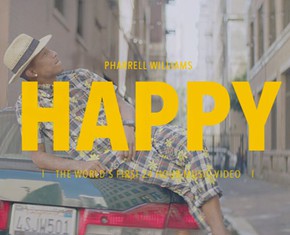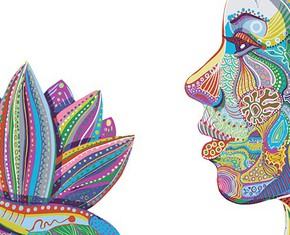The views expressed in our content reflect individual perspectives and do not represent the authoritative views of the Baha'i Faith.
Although each of us has our own musical tastes and preferences, it’s hard to escape the rest of what’s out there in the world of music. Most of us don’t often consider the kinds of music we’re exposed to and how melody impacts the brain, body and spirit, as we explored in the first segment of this series. Music affects us subliminally not only through melody but also through the imagery and language portrayed in lyrics.
Many people today are fortunate to live in societies in which free speech and artistic license are basic rights. However, when lyrics from some of the most accessible, popular, and mainstream songs contain sexualized themes, misogyny, profane language, and references to drugs, violence, and ostentatious displays of wealth, where do we draw the line?
Baha’u’llah provided clear guidance for Baha’is on the topic of messaging in music when he wrote:
We have made it lawful for you to listen to music and singing. Take heed, however, lest listening thereto should cause you to overstep the bounds of propriety and dignity. Let your joy be the joy born of My Most Great Name, a Name that bringeth rapture to the heart, and filleth with ecstasy the minds of all who have drawn nigh unto God. We, verily, have made music as a ladder for your souls, a means whereby they may be lifted up unto the realm on high; make it not, therefore, as wings to self and passion. Truly, We are loath to see you numbered with the foolish.
As a teen, I was hypersensitive to the negative messages in the songs I listened to or was exposed to, because I felt these messages were fragmented from and inconsistent with my beliefs as a Baha’i. Consequently, I began my search for alternative artists who stood out and promoted messages more coherent with my beliefs. However, these were not so easy to come by or readily accessible, especially in the mid-2000s. My exploration landed me in unfamiliar, exciting spaces, involving a new network of friends and unique methods for exchanging music that tell the origin story of my personal journey as a musician and songwriter. On this journey, my central intention was to create melodies and lyrics in a way that is guided by this observation made by Abdu’l-Baha:
… a melody, sweet to the ear, bringeth the very spirit of life to a heart in love with God, yet staineth with lust a soul engrossed in sensual desires.
RELATED: Can Music and Melody Awaken Our True Nature?
Reflecting on the above words of Baha’u’llah and Abdu’l-Baha, I’ve wondered how much they correspond to scientific findings, so I recently sought out studies on the effects of lyrics and messaging. Here’s some of what I found…
Americans listen to music 32 hours per week, on average, according to a recent report released by Nielsen Music. That gives us a sense of just how much music some of us take in!
According to a study conducted by professor P. Cougar Hall of Brigham Young University, instances of sexualization dramatically increased in lyrics during the ‘90s and 2000s—which he attributes in part to parental advisory laws that allowed artists to say whatever they want, as long as they placed advisory stickers on their album covers. The pervasive nature of these lyrics makes Hall worried that young teens will “confuse the lyrics of popular music with social norms.”
According to Deseret News, another study was reported as follows: “Male participants only listened to two different songs with misogynous lyrics and showed a considerable increase in aggression toward women. What can be said about this effect in real life, where men probably listen to hundreds of misogynous songs during their life span?”
Another researcher, Jack R. Christianson, said, “I’m not going to say that if you listen to ‘bad’ lyrics you’re going to go out and do what the lyrics suggest, but the dominating thoughts that you have in your mind are what drive your behaviors. The music allows you to remember the lyric.” He noted this process is often subconscious, because certain chords, rhythms and musical patterns (a.k.a melodies) cause hormones to be released and stimulate the brain’s pleasure centers.
These findings challenge the view held by many people that the lyrics we hear “go in through one ear and out the other.”
My personal experience also confirms this, because I’ve unintentionally used derogatory language when singing along to a song or thinking back to it in my head—and I know I’m not the only person who’s done this. Sometimes the rhythm and melody mask the message and we lose sight of what we’re actually saying.
RELATED: How Jazz Promotes Oneness: An Interview with Mtali Shaka Banda
For the record, I’m not suggesting we stop listening to music. That would be insane—and impossible, given the ubiquity of music in modern life. I’m also not suggesting we should only listen to sacred or religious music to “protect ourselves,” as this would only further exacerbate the fragmentation and sense of dichotomy. In fact, Shoghi Effendi, the Guardian of the Baha’i Faith, offered some clear guidance on this point to those with creative talents and capacities:
Music, as one of the arts, is a natural cultural development, and the Guardian does not feel that there should be any cultivation of “Baha’i Music” any more than we are trying to develop a Baha’i school of painting or writing. The believers are free to paint, write and compose as their talents guide them. If music is written, incorporating the sacred writings, the friends are free to make use of it, but it should never be considered a requirement at Baha’i meetings to have such music.
The farther away the friends keep from any set forms, the better, for they must realize that the Cause is absolutely universal, and what might seem a beautiful addition to their mode of celebrating a Feast, etc., would perhaps fall on the ears of people of another country as unpleasant sounds—and vice versa. As long as they have music for its own sake it is all right, but they should not consider it Baha’i music.
In the third and final installment of this series we will explore the empowering role of conscious listeners, consumers and creators of music, and consider in particular the role youth play in the emergence of a new culture of melody and music.
Check out BahaiTeachings Spotify for our newest monthly playlist release!
















Comments
Sign in or create an account
Continue with Googleor